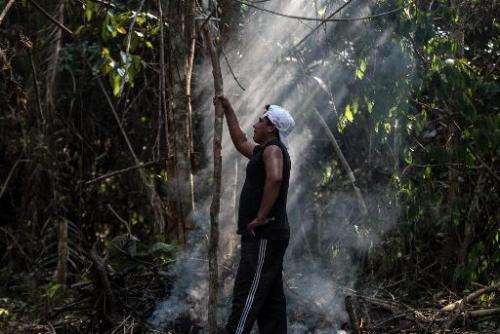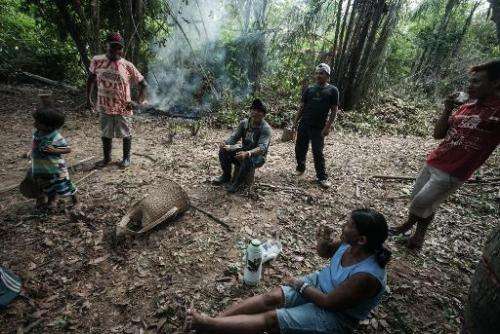Brazil Indians in race to save ancestral lands

Government foot-dragging has spurred a race by Brazil's Munduruku Indians to mark off their ancestral lands in the Amazon before they are wiped out by a planned hydroelectric complex.
Using GPS devices and machetes, a group of about 70 men, women and children have fanned out through the forested area near the Tapajos River in northern Para state over the past two weeks to fix the boundaries with stones and wooden stakes.
They have waited 13 years for the government to draw the boundaries officially recognizing their ancestral claims, to no avail.
"We are tired of waiting for the government to respond to our grievances," tribal chief Juarez Saw Munduruku, who has led the effort to mark the ancestral boundaries, told AFP.
"For years, we have tried dialogue. We have denounced a series of illegalities on our lands. But since the government has done nothing, we have decided to act."
The National Indian Foundation (FUNAI), which is responsible for Brazil's indigenous groups, had promised to publish a report in March confirming that the territory belongs to the Mundurukus, the most important step in gaining official recognition.
But the report has yet to be published, and a judge last week gave FUNAI 15 days to do so.
"The report has been ready since 2013 and it is a fundamental step for demarcating this territory, which will suffer the direct impact of the Sao Luiz do Tapajos hydroelectric dam, inundating villages, forests and cemeteries," the Para state's attorney said.

Bids to build the dam are scheduled to take place next year.
FUNAI has refused all comment on the status of the recognition process and the dam's projected impact on the Mundurukus.
"There are no fish left in our river and game is more and more difficult to find in our forests," said the Munduruku chief.
"We are tired of waiting and we have come to retake our lands. We know they belong to us, we know our own territory," he said.
Brazil's indigenous people accuse the leftist government of President Dilma Rousseff of putting the brakes on the demarcation of Indian lands.
Three to five million indigenous people were in Brazil when the Portuguese arrived in 1500, according to historians. But today they number only 896,000, spread among 305 ethnic groups, and account for 0.4 percent of Brazil's 202 million people.
Indigenous lands occupy 12 percent of Brazil's territory, most of it in the Amazon.
Recognizing and demarcating Indian lands that have been occupied by settlers to raise crops and livestock has led to conflicts of interests and the rise of a powerful agricultural lobby.
© 2014 AFP





















